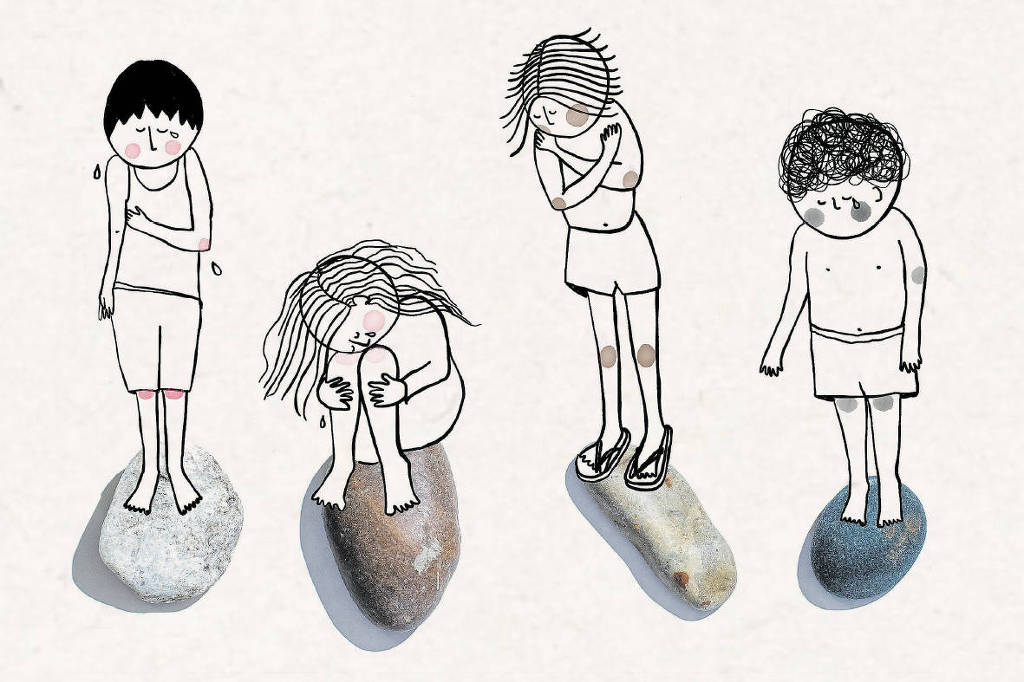
Violence in childhood can affect romantic relationships in adolescence. This is what we, researchers from the State University of Rio de Janeiro, the Federal University of Rio de Janeiro, and the Harvard School of Public Health, found in a study conducted among adolescents aged 15 to 19. The study was published in Cadernos de Saúde Pública, a partner of The Conversation Brasil.
The study was conducted among high school second-year students from public and private schools in the 9th administrative district of the city of Rio de Janeiro (including the neighborhoods of Andalay, Grajau, Maracanã, and Villa Isabel).
Despite having the fifth highest HDI (Human Development Index) in the city, the area exhibits a marked pattern of inequality. Middle- and upper-class homes, buildings, and condominiums are surrounded by shantytowns and low-income communities, such as the hilly areas of Borel, Macacos, and Complex de Andalai, characterized by a lack of basic sanitation, unstable housing conditions, and high levels of violence.
the study
To conduct the study, we identified an initial sample of 1,470 students attending 52 classes, including 5 public schools with day and night classes and 15 private schools with day classes. Sample size calculations took into account the study’s purpose of investigating the prevalence of dating violence among boys and girls.
We wanted to study not only the victims but also the perpetrators of violence. The sample was then projected onto 747 adolescents. Of these, 721 agreed to participate. However, to be included on this list, you had to have been in a romantic relationship within the past 12 months.
Within this range, 556 teenagers qualified. Due to the small number of self-reported Indigenous and Asian students, we decided to exclude them given that their inclusion in the analysis would produce inaccurate estimates for these subgroups.
Therefore, the final sample of the study consisted of 539 students, who anonymously and with guaranteed privacy completed a self-administered questionnaire about their experiences with childhood and adolescence violence, as well as personal and family characteristics.
The self-report questionnaire used was developed in Canada with a focus on detecting various forms of dating violence among adolescents. This instrument consists of 25 items divided into five subscales: physical violence, psychological violence, sexual violence, threatening behavior, and relational violence. These items have four response options: often, sometimes, rarely, and never.
Approximately 70% of participants declared some religious affiliation, with nearly half indicating Catholic or Evangelical religion. More than 80% of the sample were adolescents belonging to the middle economic class (classes B + C).
Two-fifths of participants had mothers with up to five years of education. Approximately 60% did not live with their parents. Public school students made up 40% of the sample, with only 10% attending night shifts.
violence on a date
The prevalence of victimization in the overall sample was high for all types of violence, indicating that both boys and girls frequently experience such situations.
The most frequent type of victimization was emotional, reported by 94.6% of participants. Physical violence was next, with one-third (30.1%) of adolescents saying they had already been victimized. Third place was miscellaneous threats (26.6%).
Sexual violence in dating also received attention, as touching a body part without consent or non-consensual sex already occurred in 16.7% of adolescent relationships.
The study also found that adolescents felt comfortable disclosing that they were committing such acts of violence, as the prevalence of perpetrators of such violence approached that of victims, which may indicate that these acts have become a naturalized part of romantic relationships.
It was interesting to find that there was a statistically significant difference between men and women only when it came to physical violence. Boys are the most affected. Regarding perpetration, girls reported committing additional threatening acts and physical violence against their boyfriends. On the other hand, boys committed sexual violence more frequently.
Regarding life stories, the majority of interviewees reported some form of abuse or neglect during childhood. Almost 60% of students said they had witnessed a murdered body in the street or had a family member murdered.
Approximately 40% had a friend involved in youth violence, and 80% reported drinking alcohol in the past three months. The highest incidence of dating violence was in the group that declared these very experiences.
These data suggest that strategies for victim and perpetrator acceptance need to consider the full range of experiences of violence across the lifespan.
Other research
The Centers for Disease Control and Prevention (CDC) defines dating violence as a situation involving physical, sexual, or psychological aggression or stalking in an occasional romantic-sexual or dating relationship that may occur in person or electronically between current or former partners, whether heterosexual or homosexual.
A recent meta-analytic study including data from a variety of countries estimated that 20% and 9% of adolescents, respectively, engaged in physical violence and sexual violence in the 12 months prior to the interview.
According to the same study, girls commit more physical attacks than boys (25% vs. 13%). In the case of sexual violence, girls report lower rates of perpetration (3% vs. 10%) but higher rates of victimization (14% vs. 8%).
Research shows that while dating violence can be a two-way street, research shows that girls tend to suffer more severe psychological and physical harm, and most of them are victims of sexual violence.
However, comprehensive global data on this issue, particularly studies in low- and middle-income countries, remain lacking. Despite the growing scientific literature on this topic, the number of studies is still small compared to studies focused on adult life.
In Brazil, as in other Latin American countries, there are relatively few studies quantifying problems among adolescents. The first study was just conducted in 2008 and was conducted among 3,205 students between the ages of 15 and 19 in 10 state capitals and the Federal District.
They found that 30% of participants had experienced psychological violence, 24.2% had been the victim of intimidation during a relationship, and 29.2% reported having perpetrated this type of violence in their last intimate relationship. Physical violence was reported by 24.1% of youth as the perpetrator and 19.6% as the victim.
Scientific research on the subject points to social, situational, relational, and personal determinants of dating violence. However, few epidemiological studies in Brazil have investigated whether the prevalence of dating violence varies according to specific characteristics of the population, as investigated in this study.
Specifically, only one study investigated this topic regarding its correlates with exposure to violence in childhood and adolescence, and no study examined the prevalence distribution of dating violence according to community victimization history.
message that remains
In this scenario, we noticed a high frequency of exposure to different types of violence during adolescence and a high proportion of students who reported seeing murdered bodies or having a family member killed, suggesting the cross-sectional nature of these situations in social spaces.
The sum of this adversity means that any action aimed at combating interpersonal violence must adopt a multifaceted approach and involve integrated and networked institutions.
In our opinion, schools can play an important role in this context due to their symbolic value and importance as social spaces for children and adolescents.
We believe that the entire school cycle should be considered as an opportunity to engage in positive, alternative parenting strategies to prevent abuse in parent-child relationships, support healthy relationships between intimate partners, and discuss the negative impact of interpersonal violence on youth well-being.
Furthermore, we would like to emphasize that research on dating violence and its impact on the health and quality of life of the adolescents involved is critically needed in order to enable us to better understand this issue and its subtleties and to suggest strategies for its prevention.
We hope that the findings of this study will stimulate discussion among parents, teachers, and young people.
This research was funded by the Carlos Chagas Filho Research Support Foundation of the State of Rio de Janeiro (Faperj) and the National Council for Scientific and Technological Development (CNPq).
Publication of this article was supported by the Coordination of Higher Education Officers (Capes).



